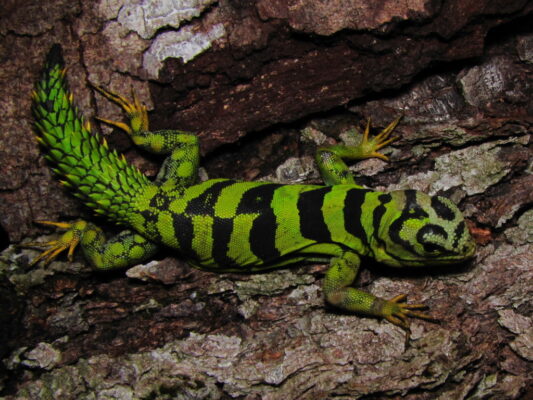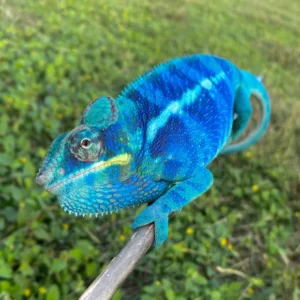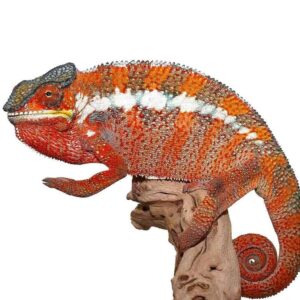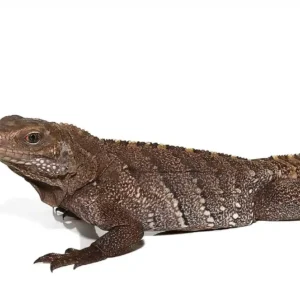Green Thorny tail Iguana For Sale
$3,499.99
WE HAVE A GREEN THORNY TAIL IGUANA FOR SALE. HERE ARE SOME HIGHLIGHTS:
- Uracentron azureum
- Captive Bred
- Approximately 4 – 5 Inches In Length From Head To Tail
- Voracious Hunters Feeding On Crickets And Other Small Insects
FUN FACTS!
- Bright Green Lizard With Distinct Black Stripes Across It’s Body And A Short Spiny Tail
- Originating From South America They Are Mostly Found In Colombia, Guyana, Brazil, And Peru
- These Are Mostly Arboreal And Thrive In Warm/ Humid Climates
Description
The Green Thorny Tail Iguana, scientifically referred to as Uracentron azureum, is a captivating reptile species that stands out due to its distinctive characteristics. Notable for its vibrant green coloration, this iguana species is easily recognizable amidst the dense foliage of its natural habitat. One of the most striking features of the Green Thorny Tail Iguana is its thorny tail, a trait that not only aids in camouflage but also serves as a defensive mechanism against predators. These physical attributes make the Green Thorny Tail Iguana a unique subject of interest among herpetologists and wildlife enthusiasts.
Native to the lush and biodiverse Amazon rainforest in South America, the Green Thorny Tail Iguana has evolved to thrive in this environment. The dense canopy of the rainforest provides an ideal setting for this arboreal species, allowing it to exhibit its remarkable climbing abilities. Adapted to an arboreal lifestyle, the iguana’s limbs and claws are well-suited for gripping and maneuvering through the intricate network of branches. This adaptation not only assists in foraging for food but also in evading potential threats.
Furthermore, the Green Thorny Tail Iguana’s diet primarily consists of a variety of insects and vegetation found in the upper layers of the rainforest. This diet, combined with its coloration and physical adaptations, underscores the iguana’s integral role in the ecosystem. The species’ presence contributes to maintaining the ecological balance, particularly in the intricate food webs of the Amazon rainforest.
In summary, the Green Thorny Tail Iguana is a remarkable example of nature’s ingenuity. Its vibrant green color, thorny tail, and arboreal adaptations not only distinguish it from other iguana species but also highlight its specialized niche within the Amazon rainforest. As we delve deeper into the fascinating world of this unique reptile, we gain a greater appreciation for the biodiversity and complexity of life in one of the world’s most vital ecosystems.
Physical Characteristics
The Green Thorny Tail Iguana, scientifically known as Uracentron azureum, exhibits an array of distinctive physical traits that make it a remarkable species. This iguana typically measures between 20 to 30 centimeters in length, including its tail. One of the most notable features is its thorny tail, which is covered in sharp, conical scales. These thorn-like structures serve a dual purpose; they act as a deterrent against predators and aid the iguana in navigating through dense foliage by anchoring itself to branches.
The scale texture of the Green Thorny Tail Iguana is another defining characteristic. Its body is enveloped in small, granular scales that provide a rough texture, enhancing its ability to grip various surfaces. This texture is particularly advantageous when climbing trees, an essential part of its arboreal lifestyle.
The vibrant green coloration of this iguana plays a crucial role in its survival. The bright green hue allows it to blend seamlessly with the lush, verdant canopy of its forest habitat. This camouflage is vital for avoiding predators and sneaking up on prey. The green color is complemented by occasional patches of blue or yellow, adding to its visually striking appearance.
Sexual dimorphism is present in the Green Thorny Tail Iguana, with males typically being larger and more robust than females. Males also exhibit more pronounced coloration and may have slightly longer tails with more developed thorn-like structures. These differences are not only important for identification but also play a role in mating rituals and territorial displays.
Overall, the physical characteristics of the Green Thorny Tail Iguana are intricately tied to its environment, providing it with the necessary tools for survival and reproduction in the wild. From its thorny tail to its bright green camouflage, each feature is an adaptation honed by evolution to ensure its continued existence in the tropical forests it calls home.
Habitat and Distribution
The Green Thorny Tail Iguana (Uracentron azureum) predominantly inhabits the lush tropical rainforests of South America, with significant populations found in Brazil, Peru, and Ecuador. These rainforests, known for their rich biodiversity and complex ecosystems, provide an ideal environment for this arboreal reptile. The iguana thrives in regions with high humidity and dense foliage, which offer both abundant food sources and ample hiding spots from predators.
Adapted to an arboreal lifestyle, the Green Thorny Tail Iguana spends the majority of its time navigating the forest canopy. Its physical adaptations, such as sharp claws and a prehensile tail, facilitate its movement through the trees. This arboreal behavior not only aids in foraging for insects, fruits, and leaves but also in avoiding ground-dwelling threats. The iguana’s preference for high perches in the canopy allows it to bask in sunlight, which is crucial for thermoregulation.
Seasonal variations also play a role in the habitat use of the Green Thorny Tail Iguana. During the wet season, the iguana benefits from the increased availability of food and water, which supports its active lifestyle. Conversely, in the dry season, the iguana may exhibit more conservative behaviors, such as reducing its activity levels and seeking out microhabitats that retain moisture. This seasonal adaptability is vital for its survival in the dynamic rainforest environment.
Overall, the Green Thorny Tail Iguana’s habitat preferences and arboreal adaptations highlight its specialized niche within the tropical rainforests. These factors, coupled with its ability to navigate seasonal changes, underscore the iguana’s resilience and evolutionary success in one of the most complex biomes on Earth.
Diet and Feeding Habits
The Green Thorny Tail Iguana (Uracentron azureum) exhibits an omnivorous diet, reflecting its adaptability to a variety of food sources within its natural habitat. This iguana primarily consumes a mix of fruits, leaves, insects, and even small vertebrates, ensuring a balanced intake of nutrients essential for its health and survival.
One of the key aspects of the Green Thorny Tail Iguana’s diet is its preference for certain fruits and leaves. Commonly, it forages for fruits such as figs, berries, and other native forest fruits, which provide vital vitamins and hydration. Additionally, the leafy greens it consumes, including young shoots and tender leaves, are crucial for its digestive health and overall well-being.
Insects constitute another significant portion of the Green Thorny Tail Iguana’s diet. It actively hunts for a variety of insects, including beetles, caterpillars, and grasshoppers, which are rich in protein. The iguana’s keen eyesight and agile movements make it an efficient predator of these small creatures. Interestingly, its prehensile and thorny tail plays a pivotal role during hunting. The tail not only offers balance and support but can also be used to swat at insects, stunning them before consumption.
Small vertebrates, though not a staple, are occasionally part of the Green Thorny Tail Iguana’s diet. This includes small lizards and even juvenile birds, which the iguana can capture thanks to its agility and stealth. These prey items provide additional protein and other nutrients that are beneficial, particularly during the iguana’s growth phases.
Specific plants and insects are notably crucial to the Green Thorny Tail Iguana’s diet. For example, certain species of beetles and caterpillars are sought after due to their high protein content, while particular figs and berries are favored for their nutritional and hydrating properties. Understanding these dietary preferences is essential for conservation efforts, as it highlights the importance of preserving the iguana’s natural habitat, ensuring these food sources remain abundant.
Behavior and Social Structure
The Green Thorny Tail Iguana exhibits a fascinating array of behavioral patterns, reflecting its solitary and territorial nature. Unlike many other reptile species that may form complex social groups, these iguanas prefer to live alone, establishing and defending their own territories with great determination. The territorial behavior of the Green Thorny Tail Iguana is marked by a clear demarcation of boundaries, often signaled through a series of assertive displays and physical gestures.
Communication among Green Thorny Tail Iguanas primarily relies on body language and visual signals. These iguanas employ a repertoire of movements, such as head bobbing, dewlap extension, and tail flicking, to convey messages to potential rivals or mates. For instance, a series of rapid head bobs can serve as a warning to intruders, while a slow, deliberate head bob might be used during courtship. The dewlap, a flap of skin beneath the chin, is extended to appear more intimidating or to attract attention. Tail movements, including flicking or curling, further augment these visual signals, enhancing their ability to communicate effectively without the need for vocalization.
The activity patterns of the Green Thorny Tail Iguana are influenced by environmental factors, most notably the availability of sunlight. Basking in the sun is a crucial behavior for these reptiles, as it allows them to regulate their body temperature and absorb the necessary ultraviolet rays for vitamin D synthesis. During the daylight hours, iguanas can often be found perched on branches or rocks, soaking up the sun’s warmth. However, as the day transitions to night, their activity levels diminish, and they seek refuge in sheltered locations, demonstrating a partial nocturnal habit that ensures their safety from nocturnal predators.
Understanding the behavior and social structure of the Green Thorny Tail Iguana provides valuable insights into their adaptation strategies and survival mechanisms in the wild. By observing their solitary and territorial tendencies, along with their sophisticated communication methods, researchers can gain a deeper appreciation of the complex lives these reptiles lead.
Reproduction and Lifespan
The reproductive cycle of the Green Thorny Tail Iguana is an intricate and fascinating process that involves distinct mating rituals, nesting behaviors, and egg-laying procedures. During the breeding season, which typically occurs in the warmer months, male iguanas engage in territorial displays and physical confrontations to attract females. These displays often include head bobbing, body posturing, and the use of vibrant coloration to signal fitness and readiness to mate.
Once a male has successfully attracted a mate, the female Green Thorny Tail Iguana will select a suitable nesting site. This is usually a location with loose, sandy soil where she can dig a burrow to lay her eggs. The female lays a clutch of 10 to 20 eggs, which she carefully covers with soil to protect them from predators and environmental extremes. The incubation period for the eggs is approximately 90 to 120 days, depending on the ambient temperature and humidity levels.
Upon hatching, the young iguanas are highly independent, requiring minimal parental care. They are equipped with the necessary instincts to forage for food and evade predators from birth. Juvenile Green Thorny Tail Iguanas grow rapidly during their first year, reaching near-adult size within 12 to 18 months. Their diet during this period consists primarily of insects and small invertebrates, gradually incorporating more plant material as they mature.
The average lifespan of the Green Thorny Tail Iguana varies significantly between wild and captive environments. In the wild, these iguanas face numerous threats, including predation, habitat destruction, and competition for resources, which often limits their lifespan to around 8 to 10 years. In contrast, iguanas kept in captivity, where they are provided with optimal care, nutrition, and protection, can live up to 15 to 20 years. This extended lifespan in captivity underscores the importance of proper husbandry practices and the role of conservation efforts in ensuring the longevity and well-being of this remarkable species.
Conservation Status and Threats
The Green Thorny Tail Iguana, scientifically known as Uromastyx aegyptia, is currently facing several significant threats that impact its survival. According to the International Union for Conservation of Nature (IUCN), the species is classified as “Vulnerable.” This designation underscores the urgent need for conservation efforts to prevent further decline in their population.
One of the primary threats to the Green Thorny Tail Iguana is habitat destruction. The expansion of agricultural activities, urban development, and deforestation are leading to the fragmentation and loss of their natural habitats. These iguanas thrive in arid and semi-arid environments, which are increasingly being converted for human use, reducing the areas where they can live and forage.
Climate change also poses a significant threat to the Green Thorny Tail Iguana. Rising temperatures and changing precipitation patterns can disrupt their breeding cycles, food availability, and overall habitat suitability. As ectothermic reptiles, their survival is closely tied to environmental conditions, making them particularly vulnerable to climate fluctuations.
The pet trade further exacerbates the plight of the Green Thorny Tail Iguana. These iguanas are often captured in the wild and sold as exotic pets, which not only reduces their numbers in the wild but also subjects them to stressful conditions during capture and transport. The illegal pet trade remains a persistent issue despite regulatory efforts.
In response to these threats, various conservation programs and protective measures have been implemented. Protected areas have been established to safeguard critical habitats, and breeding programs in captivity aim to bolster their numbers. Additionally, public awareness campaigns are being conducted to educate communities about the importance of preserving this unique species and discouraging the capture and trade of wild iguanas.
Preserving the natural habitat of the Green Thorny Tail Iguana is paramount to its survival. These iguanas play a crucial role in their ecosystems, and their conservation is vital for maintaining ecological balance. Collaborative efforts between governments, conservation organizations, and local communities are essential to ensure the long-term survival of the Green Thorny Tail Iguana.
Interesting Facts and Myths
The Green Thorny Tail Iguana, scientifically known as Ctenosaura similis, is a remarkable species with several intriguing facts and myths surrounding it. One of the most unique behaviors of this iguana is its tail, which is adorned with thorn-like spines, serving both as a defense mechanism and a tool for climbing. These spines make the iguana particularly adept at navigating the rocky terrains and dense forests of Central America, where it is commonly found.
A lesser-known trait of the Green Thorny Tail Iguana is its ability to change color slightly. While not as dramatic as the color changes seen in chameleons, this iguana can adjust its shade to better blend with its surroundings, aiding in camouflage. Additionally, these iguanas are known for their remarkable speed and agility, often surprising predators and researchers alike with their quick movements.
There are several myths about the Green Thorny Tail Iguana that need to be dispelled. One common misconception is that they are aggressive towards humans. In reality, these iguanas are generally shy and prefer to flee rather than confront. Another myth suggests that their tail spines are venomous. This is completely false; the spines are purely a physical deterrent to predators, causing no harm beyond their sharpness.
In local cultures, the Green Thorny Tail Iguana holds a significant place in folklore. In some indigenous communities, they are considered symbols of agility and resilience. Stories often depict them as creatures that embody the spirit of survival and adaptability, traits that are highly valued in these cultures. Furthermore, they are sometimes featured in traditional art and crafts, highlighting their importance in the cultural tapestry of the regions they inhabit.
Overall, the Green Thorny Tail Iguana is not only a fascinating subject for herpetologists but also a creature deeply embedded in the cultural narratives of its native habitat. Understanding the facts and debunking myths about this unique species helps in appreciating its true nature and significance.






